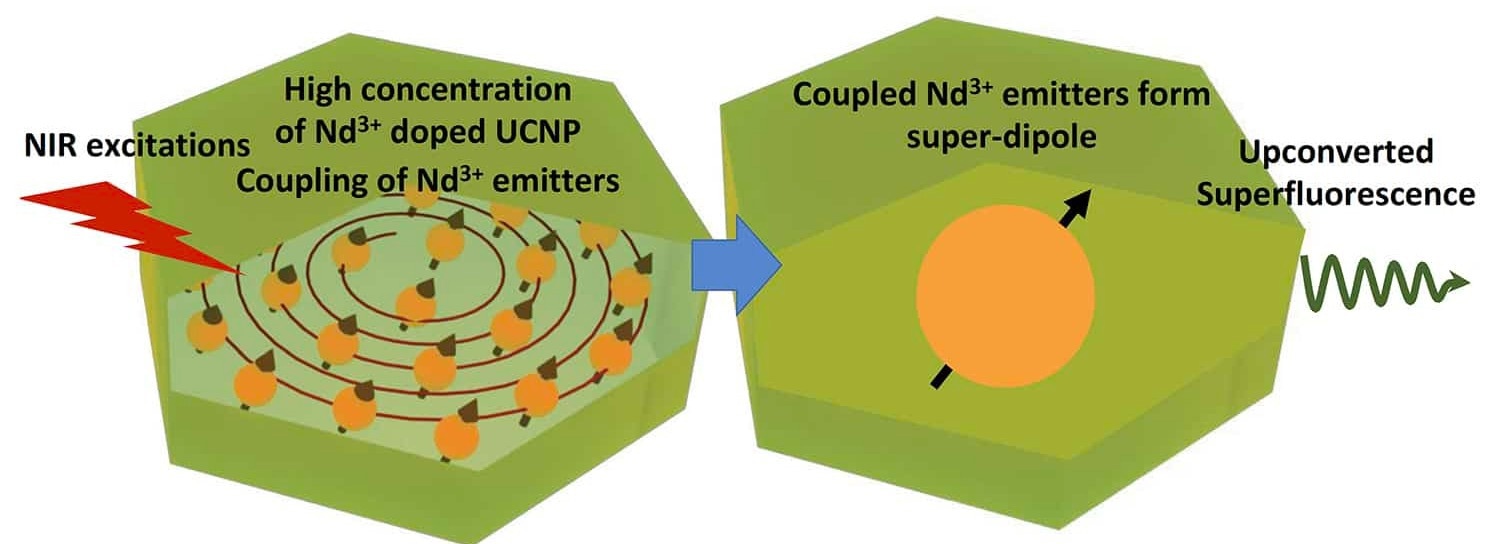Instead of producing a brighter and more stable nanoparticle for optical applications, scientists discovered that their creation displayed a more unforeseen property: bursts of superfluorescence that happened at room temperature and regular intervals.
 The process for achieving superflorescence at room temperature is shown in a new paper in Nature Photonics. Image Credit: North Carolina State University
The process for achieving superflorescence at room temperature is shown in a new paper in Nature Photonics. Image Credit: North Carolina State University
The research could result in several biological studies as well as the creation of quicker microchips, neuro sensors, or materials for use in quantum computing applications.
When the atoms of a substance coordinate and simultaneously emit a brief but powerful burst of light, it is known as superfluorescence. Although crucial for quantum optical applications, the property is extremely challenging to attain at room temperature and for long enough durations to be of use.
The research team created the substance in issue, lanthanide-doped up conversion nanoparticle, or UCNP, to produce a “brighter” optical substance. They created hexagonal ceramic crystals with sizes ranging from 50 nanometers (nm) to 500 nm, tested their lasing capabilities, and made many significant advances.
Initially, the researchers were searching for lasing, a phenomenon in which one atom’s light induces another to emit more of the same light. Instead, they discovered superfluorescence, in which all of the atoms first align before emitting collectively.
When we excited the material at different laser intensities, we found that it emits three pulses of superfluorescence at regular intervals for each excitation. And the pulses do not degrade—each pulse is 2 nanoseconds long. So not only does the UCNP exhibit superfluorescence at room temperatures, it does so in a way that can be controlled.
Shuang Fang Lim, Research Co-Corresponding Author and Associate Professor, Physics, North Carolina State University
Since it is challenging for atoms to emit simultaneously without being “kicked” out of alignment by their surroundings, room temperature superfluorescence is challenging to produce.
However, in a UCNP, light is produced by electron orbitals that are “buried” beneath other electrons. These orbitals serve as a shield and permit superfluorescence even at normal temperatures.
Moreover, the superfluorescence at UCNP is anti-Stokes shifted, which means that the light wavelengths released are shorter and more energetic than the light wavelengths that trigger the response.
Such intense and rapid anti-Stokes shift superfluorescence emissions are perfect for numerous pioneering materials and nanomedicine platforms. For example, the UCNPs have been widely used in biological applications ranging from background noise-free biosensing, precision nanomedicine and deep-tissue imaging, to cell biology, visual physiology, and optogenetics.
Gang Han, Research Co-Corresponding Author and Professor, Biochemistry and Molecular Biotechnology, University of Massachusetts Chan Medical School
Han added, “However, one challenge to current UCNP applications is their slow emission, which often makes detection complex and suboptimal. But the speed of anti-Stokes shift superfluoresence is a complete game changer: 10,000 times faster than the current method.”
He further stated, “We believe that this superfluorescence nanoparticle provides a revolutionary solution to bioimaging and phototherapies that await a clean, rapid and intensive light source.”
Due to its special characteristics, UCNP can find utility in many applications.
Lim concluded, “First, room temperature operation makes applications much easier. And at 50 nm, this is the smallest superfluorescent media currently in existence. Since we can control the pulses, we could use these crystals as timers, neurosensors or transistors on microchips, for example. And bigger crystals could give us even better control over the pulses.”
The US Army Research Office provided funding for the study under grant number W911NF2110283. The first author is UMass Chan Medical School postdoctoral researcher Kai Huang.
Journal Reference:
Huang, K., et al. (2022) Room-temperature upconverted superfluorescence. Nature Photonics. doi:10.1038/s41566-022-01060-5.